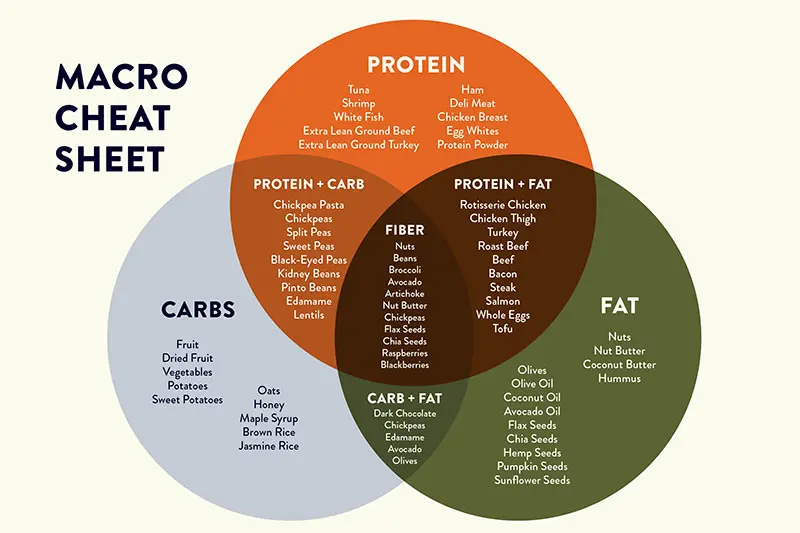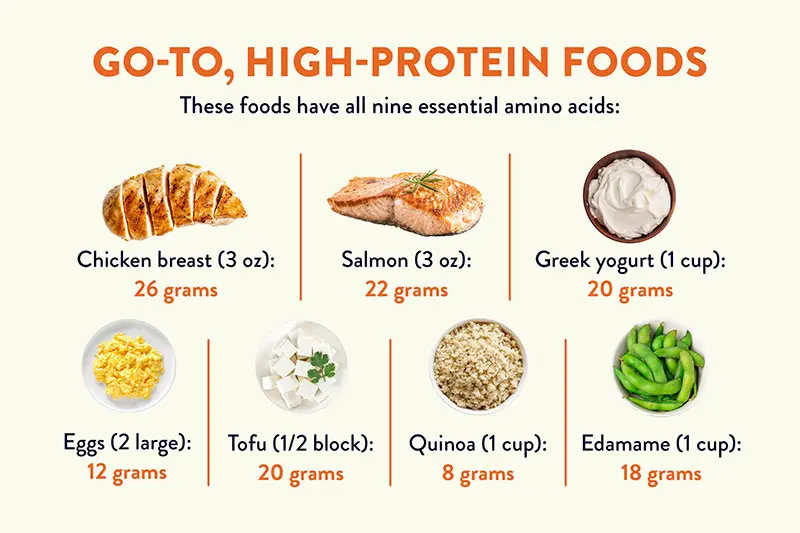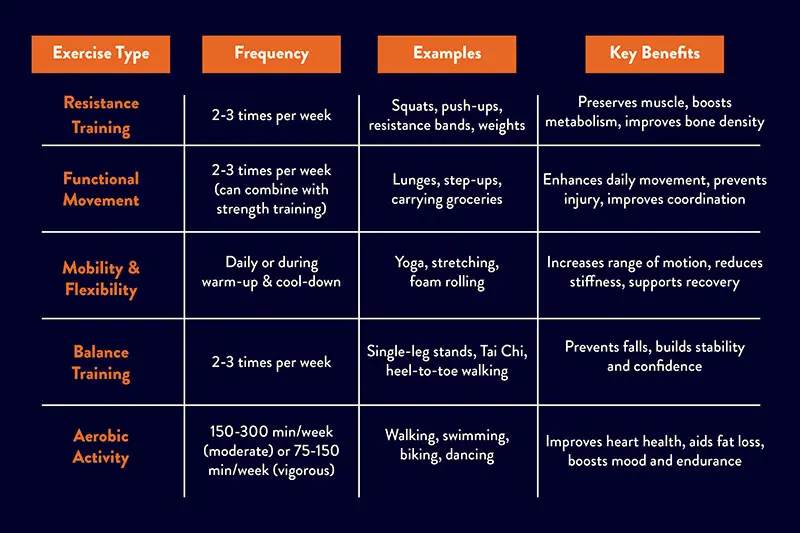
Welcome to Month 2 of your Weight Care program! If you haven’t seen major shifts yet, don’t worry—that’s completely normal. Many people begin to notice more visible progress in the coming weeks. In the meantime, know that your clinical team at Alloy is here to guide and support you every step of the way. You’re doing the work, and it’s adding up. Keep going.
As we covered last month, reaching a healthy body weight is not just about medication. You’ll experience the best results when you create—and then stick to—healthy lifestyle habits, including good nutrition, strength training, solid sleep, and stress management.
Going forward, we’ll focus on leveling up the health foundation you’ve already built to set you up for long-term weight loss and metabolic health. Let’s build on your momentum…
Focus on Protein
In midlife, protein matters even more than in earlier life stages. As we age, muscle mass naturally declines, and that process accelerates after menopause. And that matters beyond aesthetics.
Think of muscle as your body’s metabolic powerhouse. It acts as a storage site for amino acids—the building blocks of protein that you get from the food you eat. Your body taps into this reservoir to fuel protein synthesis, the process that keeps your immune system strong, your brain sharp, your hair and nails healthy, your heart and lungs functioning optimally, your muscles fueled, and more.
When we lose weight—whether through GLP-1 medications or other methods—we often lose some lean muscle along with fat. That’s why it’s crucial to prioritize protein: It helps preserve your muscle mass during weight loss. Protein also supports appetite regulation by reducing hunger hormones and increasing feelings of fullness after meals. Of all the macronutrients, it’s the most satiating—making it easier to naturally eat fewer calories without feeling deprived.
Dr. Montville’s challenge to you this month? Get serious about protein. Not because it’s trendy—but because it is one of the most powerful tools midlife women have for protecting (and building) muscle, managing hunger, and staying strong for the long haul.
Here’s how:
Use this ballpark goal: 1.2–1.5g of protein per kg of ideal body weight. Let’s say that’s 150 lbs for you, then you will aim for 82–102g/day.
Protein works like a light switch. You need at least 20–30g in a meal to flip it on and trigger muscle protein synthesis.
Your body maxes out being able to use protein once you hit about 40g—so spread it out through meals and snacks throughout the day.
Track protein without overthinking it. Use your Notes app, ChatGPT, a free app tracker, or take pictures of your meals to estimate.
Choose whole foods over packaged ones when possible. Go for minimally processed proteins you actually enjoy—grilled salmon, lentils with olive oil, eggs with a sprinkle of feta—over “nutrition” bars that are often full of sugar and sodium.

Not all protein is created equal, here’s what to know…
To truly support muscle, metabolism, and mood, your body needs all nine essential amino acids—the ones it can’t make on its own. That’s where your protein source matters.
Animal-Based: Eggs, chicken, salmon, Greek yogurt, cottage cheese—these are protein all-stars because they deliver the full amino acid lineup.
Plant-Based: Lentils, tofu, tempeh, edamame, quinoa, chia seeds, and soy milk can absolutely get the protein synthesis job done—but it takes some strategy. You’ll need to combine foods to consume all nine essential amino acids, like this: rice + beans or tofu + veggies. If you’re plant-based, consider checking in with your Alloy doctor to make sure your meals are hitting all the right notes.
Bonus MVPs: Leafy greens, colorful veggies, nuts, and seeds deliver fiber, vitamins, and a little extra protein.
Bottom line: Your muscles can’t grow—or stay strong—without the right building blocks.

Building Strength & Muscle Mass
As people get older (starting at around age 30), they lose muscle mass. In fact, women can lose about 3–8% of muscle mass per decade if they don’t take action. So, incorporating strength, functional training, mobility, and balance work into your weight loss plan is crucial for:
Metabolism Your Basal Metabolic Rate (BMR) goes up with increased lean muscle mass because muscle tissue is so metabolically active, meaning it requires more energy (calories) to maintain than fat tissue—even when you’re not moving. One pound of muscle uses about 6–7 calories per day simply to sustain itself, compared to only 2 calories for a pound of fat.
Body composition An improved fat-to-muscle ratio boosts overall health.
Insulin sensitivity Reduces risk for type 2 diabetes and metabolic syndrome.
Bone density Exercise improves bone mineral density, reducing fracture risk.
Quality of life Gaining strength and feeling more confident allows you to participate in a wider range of activities.
Injury prevention Strength, balance and stability help us avoid (or safely recover from) slips and falls that can lead to medical complications.
Strength/Resistance Training
Moves that target individual muscles, like biceps curls and triceps dips, have their place—but how often do you actually use those muscles on their own in everyday life? Most of your resistance training should focus on functional movements that mirror the way your body moves day-to-day: squatting to pick something up, pushing a heavy door, or reaching overhead.
The exercises below train those real-world movement patterns. They not only build strength and coordination but also emphasize pushing and pulling, which support tendon health, joint function, and even stimulate bone remodeling—a key factor in maintaining bone density, especially in midlife and beyond.
If you’re feeling unsure or overwhelmed, booking a one-on-one session with a certified trainer can be a game changer. It’s a great way to build confidence, learn proper form, and tailor your workout to your body and goals.
That said, you don’t need to join a gym to do basic strength exercises, nor do you need to spend money on equipment for a home gym—you can do a lot in your house, backyard, or park. The Centers for Disease Control and Prevention (CDC) recommends incorporating muscle-strengthening exercises at least two days per week to preserve lean muscle mass and improve metabolic health. Here are some ways to get started:
Foundational moves You’ve heard of them for a reason: squats, push-ups, lunges, bent-over rows, and planks are foundational because they train the movement patterns you use every day.
Progressive overload Consistently increase your challenge with more weight, reps, or resistance (scroll down for how to do that). That’s how you spark continued muscle growth and strength gains.
Tempo and pauses If you don’t have strength training equipment at home, try slowing your reps way down (3–5 second eccentric/lowering phase) or add isometric holds at the hardest part of the movement. These methods increase your time under tension, which helps not just preserve, but build, muscle.
Elevated surface variations Use stairs, a coffee table, or even your bed frame for incline/decline pushups, Bulgarian split squats, or hip thrusts. Elevation changes the intensity dramatically.
Single-limb everything Turn basic moves into balance + strength challenges by doing them unilaterally: single-leg glute bridges, single-arm pushups against a wall, or single-leg squats to a chair.
Resistance bands + towels Loop a towel around a door handle and pull against it for rows, or use long resistance bands to mimic cable machine exercises—lat pulldowns, face pulls, or resisted pushups.
Loaded carries Grip a heavy object (like a laundry basket filled with books) around your home slowly and mindfully. This mimics a farmer’s carry and works core, grip, and posture muscles.
Backpack hack Fill it with books, then wear it during squats, pushups, for walking up a flight of steps, or planks and add more weight each week to progressively overload.
Mobility And Flexibility Training
Both modalities are important for improving posture, preventing injury, and enhancing your ability to move with ease through everyday life. Flexibility training focuses on the muscles themselves, lengthening and stretching to reduce stiffness and pain. Mobility training emphasizes joint health by improving the range of motion, alleviating pain, and making joints less prone to injury. All of this is especially crucial in post-menopausal women, when osteoporosis is a significant concern.
Try pairing some of the feel-good stretches below with deep breathing—inhale for four counts, then exhale for six counts. This helps calm your nervous system and eases stress. Win-win.
Before-Bed Relaxation Stretches
Legs Up the Wall: Lie on your back with your legs extended up a wall or resting on a couch. Scoot your hips close to the base of the wall.
Supine Twist: Lie on your back, hug your knees in, then gently drop them to one side. Keep shoulders grounded.
Neck Release: Sit or lie down. Tilt your head to one side, bringing your ear toward your shoulder. Optional: Use your hand for a (gentle!) pull.
At-Your-Desk Stretches
Seated Spinal Twist: Sit tall, twist to one side grasping chair arm. Hold 20 seconds each side.
Wrist & Forearm Stretch: Extend one arm, palm out, gently pull back on fingers with the other hand.
Seated Figure Four: Cross one ankle over opposite knee and hinge forward.
Balance Training
Balance declines with age, increasing the risk of falls. So it’s important to focus on improving coordination and postural alignment. “Single side” work, such as standing on one leg, or pressing a weight overhead with one arm then the other, is tops for improving stability. (You can even try balancing while doing tasks around your home, like brushing your teeth.)
Aerobic Activity
Any form of sustained, rhythmic physical activity that uses large muscle groups, and elevates the heart rate and breathing, will benefit your cardiovascular system. The CDC suggests:
At least 150 to 300 minutes of moderate-intensity aerobic exercise per week (e.g., brisk walking, cycling).
Or 75 to 150 minutes of vigorous-intensity aerobic activity per week (e.g., running, swimming).
A combination of the two.
Dr. Montville’s Weekly Recommendations:

Get a Good Night’s Sleep
Solid sleep is not a “nice to have”; it’s an integral part of your weight-loss program. Why? For women in midlife, disrupted sleep is common because of menopause symptoms, chronic stress, caring for children and/or aging parents, work responsibilities, and other health issues. Sub-par sleep contributes directly to weight gain, insulin resistance, and even heart attack risk.
Restorative sleep can help regulate metabolism, reduce appetite, and improve mood—all essential for sustainable weight loss. Here are some tips to improve your sleep quality…
Get 7–9 hours of consistent, high-quality sleep. Anything less than 6–7 hours has been shown to increase hunger, cravings, and caloric intake, especially of high-fat, high-carb foods.
Set a consistent bedtime routine, which means going to bed and waking up at the same time every day. Fragmented sleep—even with adequate total time—alters metabolic markers and appetite control.
Keep your room cool: A too-warm room impacts sleep quality, according to studies. Opt for 67 degrees or cooler.
Address menopausal symptoms like hot flashes and night sweats—talk to your doctor about Menopausal Hormone Treatment (MHT).
Manage stress with relaxing techniques like warm baths (which has the added benefit of lowering your core temperature before bed), meditation and deep breathing.
Make sure your sleep environment is optimal (cozy bedding and minimal noise in a dark, quiet room).
Create a contingency plan if you wake up in the night and can’t fall back to sleep: try to avoid looking at your clock (which will stress you out more), do some deep breathing (which can help relax you and any agita you’re experiencing), and consider reading a book (avoid scrolling on your phone).
Mindset Check-In
As your body changes, your emotional and mental state needs attention as well. How are you feeling? What has been difficult in this journey and what’s gotten easier? Are you noticing the lack of “food noise” (constant, intrusive thoughts about food)? That absence is one of the most striking ways your body may react to a GLP-1 medication—and for a lot of people that quieting is a major source of relief. I hope it is for you.
Last month we talked about how adopting a “growth mindset” can be hugely, positively impactful. The idea is that you don’t punish yourself for setbacks: Instead, aim to embrace challenges, learn from mistakes, and celebrate your progress—even the smallest of wins.
This is a great time to connect with your doctor at Alloy. Discuss your progress, your concerns, side effects, and your overall health. At Month 2, you’ll need to re-up your prescription—talk to your doctor about dosage adjustments or any other changes.
Month 2 Activity
Check in on the S.M.A.R.T. goals you set last month. What were your challenges achieving your goals? What would you change to overcome those challenges? What were your wins? What can you do to make those wins "repeatable"?
Do you want to tweak your goals to make them more realistic and repeatable, or are you ready to come up with new ones? If you discussed them with your doctor, what came out of that conversation?
Here’s a suggestion: Track your food intake, exercise, and sleep from one day last week. Send it to your doctor for assessment and feedback.
Next month will bring even more changes and we’ll tackle issues including inflammation, gut health, and emotional health. We’re so excited to be with you on this journey. Keep up the good work!
Sources
https://academic.oup.com/sleep/article/43/Supplement_1/A464/5847198
https://pubmed.ncbi.nlm.nih.gov/38309825/
https://pmc.ncbi.nlm.nih.gov/articles/PMC2804956/
Hunter GR, McCarthy JP, Bamman MM. “Effects of resistance training on older adults.” Sports Medicine (2004);34(5): 329–348.Daly RM, Rosengren BE, Alwis G, Ahlborg HG, Sernbo I, Karlsson MK. “Gender-specific age-related changes in bone density, muscle strength and functional performance in the elderly: a 10-year prospective population-based study.” BMC Geriatrics (2013); 13: 71.
Subscribe
Go ahead, you deserve to
feel fantastic
By subscribing you agree to our Terms of Service & Privacy Policy.